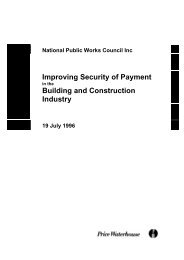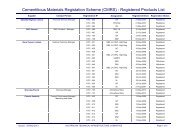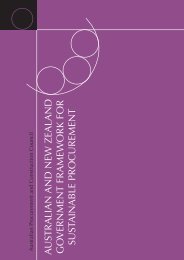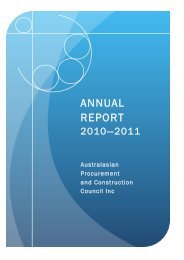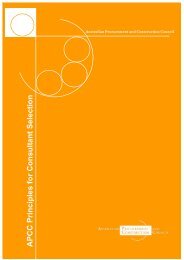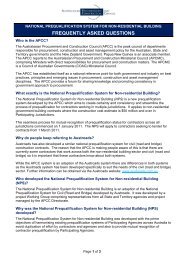ESD design guide for Australian Government buildings: Edition 2
ESD design guide for Australian Government buildings: Edition 2
ESD design guide for Australian Government buildings: Edition 2
You also want an ePaper? Increase the reach of your titles
YUMPU automatically turns print PDFs into web optimized ePapers that Google loves.
esd opportunities in building<br />
OPPORTUNITY 4<br />
minimising energy use<br />
Figure 23. Photovoltaic curtain wall, image<br />
sourced from Doncaster Hill Sustainability<br />
Guidelines, Manningham City Council.<br />
Figure 24. Integrated amorphous<br />
photovoltaic tiles, image sourced from<br />
Doncaster Hill Sustainability Guidelines,<br />
Manningham City Council.<br />
(i.e. <strong>for</strong> photocopiers, computers,<br />
etc.) is one method to minimise<br />
operational energy use. This <strong>guide</strong><br />
does not provide detailed advice in<br />
this area, but an effective purchasing<br />
policy, energy saving settings and<br />
periodic review of equipment settings<br />
(people often turn efficiency settings<br />
off when they don’t understand their<br />
function) are initiatives to consider. For<br />
more in<strong>for</strong>mation see the DEH Green<br />
Office Guide and DEH’s voluntary<br />
environmental purchasing tools (refer<br />
to online resources).<br />
RENEWABLE ENERGY<br />
Green Power, Solar Hot Water and<br />
Photovoltaic systems<br />
One main technique <strong>for</strong> minimising<br />
the greenhouse intensity of the energy<br />
used in a building is to use green<br />
power (electricity which comes from<br />
wind, water or solar sources) and/or to<br />
use a cogeneration system.<br />
Using solar energy <strong>for</strong> the provision<br />
of hot water is another method <strong>for</strong><br />
using renewable energy and reducing<br />
the greenhouse impact of a building.<br />
Solar hot water systems involve<br />
pumping water through pipes that<br />
are laid on an absorber plate. Both of<br />
those are coated with heat absorbing<br />
material. The pipes and plate are<br />
mounted in the sun’s direction to<br />
maximise heat absorbance. The water<br />
absorbs heat and transfers this heat<br />
to a storage tank where it is collected<br />
and ready <strong>for</strong> use when required.<br />
A photovoltaic system (PV) uses<br />
solar energy to generate electricity.<br />
PV panels are made with a positive<br />
and a negative layer of silicon. When<br />
light falls on these layers, it produces<br />
a potential difference (photovoltage)<br />
between the layers by causing<br />
electrons within the layers to move.<br />
If an external circuit is present, this<br />
voltage can drive a current through it.<br />
This current is then converted to AC<br />
current (the type of current used in the<br />
office) via an inverter. This can then<br />
power normal office appliances and<br />
lights. If the office is connected to the<br />
mains electricity, excess energy can<br />
be redirected to the grid and the meter<br />
turned backwards.<br />
EMBODIED ENERGY<br />
MINIMISATION<br />
Embodied energy is discussed in<br />
opportunity 7 choosing materials.<br />
26 SEAV (2005) Personal Conversation Sustainable<br />
Energy Authority Victoria 9/3/2005.<br />
27 Craw<strong>for</strong>d R.H. and Treloar G.J. (2004) Net energy<br />
analysis of solar and conventional domestic<br />
hot water systems in Melbourne, Australia Solar<br />
Energy, vol. 76 (1-3), January-March 2004, pp.<br />
159-163.<br />
28 Going Solar 2005, Conversation 9/03/05.<br />
29 E. A. Alsema and E. Nieuwlaar Energy viability of<br />
photovoltaic systems Energy Policy, Volume 28,<br />
Issue 14, November 2000, Pages 999-1010.<br />
Effectiveness of<br />
hot water and PV systems<br />
Domestic hot water<br />
cost payback: 6-7 years 26<br />
embodied energy<br />
payback: 0.5-2 yrs 27<br />
Domestic and commercial<br />
photovoltaic systems<br />
cost payback: Greater than 10<br />
years 28<br />
embodied energy<br />
payback: 2.5-3 yrs 29<br />
Online Resources<br />
Passive Design Techniques<br />
Square One<br />
www.squ1.com<br />
Sustainable Building Sourcebook<br />
www.greenbuilder.com/sourcebook/<br />
PassiveSol<br />
Renewable Energy<br />
Greenpower<br />
www.greenpower.com.au/<br />
Solar Power<br />
ATA (Alternative Technology<br />
Association)<br />
www.ata.org.au/<br />
National Renewable Energy<br />
Laboratory<br />
www.nrel.gov/solar/<br />
Energy Efficient Fittings & Equipment<br />
<strong>Australian</strong> Greenhouse Office<br />
Toolkit <strong>for</strong> local <strong>Government</strong><br />
www.greenhouse.gov.au/lgmodules<br />
Department of the Environment and<br />
Heritage<br />
Environmental Purchasing Guide<br />
www.deh.gov.au/settlements/government/<br />
purchasing<br />
Green Office Guide<br />
www.deh.gov.au/settlements/government/<br />
purchasing/pubs/<br />
<strong>ESD</strong> DESIGN GUIDE FOR AUSTRALIAN GOVERNMENT BUILDINGS 023


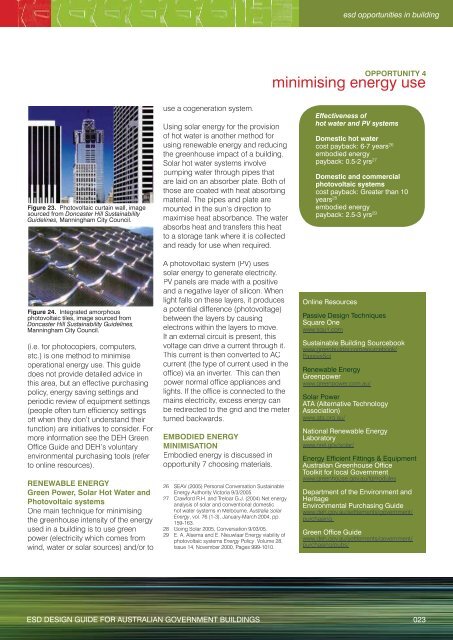
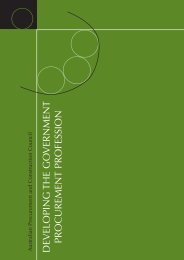
![NATIONAL COST ADJUSTMENT PROVISION EDITION 2 [NCAP2]](https://img.yumpu.com/48266135/1/184x260/national-cost-adjustment-provision-edition-2-ncap2.jpg?quality=85)
